
HISTORY OF PRESTON - Page 1 - up to 1780
| 1780 to 1900 | 1900 to now | Harris Museum | Map of Preston |
|---|
Click here for History Books about Preston
Ancient manufacturers were in the area of Preston. Mining iron ore and producing iron on a small scale. Preston has evidence of Bronze Age life on display in the Harris Museum in the city centre. Common items for the age; arrowheads, canoes. After that the Romans came bringing Watling Street Road, Walton, Ribchester. Also later, Norsemen, as evidenced by the Cuerdale Hoard. The area was ruled by the Normans and then as the Duchy of Lancaster directly by the monarch, The Duke of Lancaster.
Preston was a battleplace in the Jacobite Rebellion and the Civil War.
Like many places in Europe and the USA, the industrial revolution transformed Preston from a small town of 10,000 to over 100,000 in a relatively short time and then stabilised. From an agricultural and administrative centre to an industrial one and then to a service based centre.
(Note: please use the below for information that might guide you towards the finding out more and deciding if it is correct or not. We'd like to know if you think it isn't correct.)
Quick View of Very Old Times up to AD1066
12,000 years ago was the end of the ice age, glaciers were retreating from the area and hunters were moving in walking from what is now France. These hunters are in evidence as exemplified by the Poulton Elk, one of the main displays in the Harris Museum. This elk was found with injuries and arrowheads and has been dated from around 10,000 b.c.

End of the Ice Age Conditions
Ron Cowell, formerly of Preston, Curator of Pre-Historic Arhaeology at Liverpool Museum, who was recently (Oct 2012) on the BBC TV programme 'Inside Out' featuring a dig near Southport, sent me some information 'off the top of his head' which I have used below.
'The elk belongs to a time about 300 or 400 years into a period of sudden warming at the end of the ice age, beginning about 14700 years ago, when Britain was re-occupied from the continent as it had been too cold for people previously, and birch woodland slowly became widespread and temperatures were close to those of today.
In effect though, there is always a delay for the spread of woodland, so although it became warmer very quickly, perhaps within about ten years the ice age climate disappeared, woodland would have spread much slower, over many centuries, from the continent so that it was most common by the time a mini ice age hit at about 12500 years ago. The country was essentially depopulated again until after 11300 years ago, when the warm phase that we are living in now began (Take 2000 off if you want the BC dates for all this).
From what I remember of the story, therefore it's at the end of the ice age as the former arctic grassland vegetation was changing as things warmed up. The elk died in a glacial kettle-hole in a generally tundra like environment, although I think there would be some woodland and herbaceous vegetation not too far away in order to support the animal and human life at this time.'
End of the Ice Age
According to the book 'Prehistoric Lancashire' by David Barrowclough, ice extended around 20 miles beyond Blackpool and the coast was even further out as the sea was around 20 metres lower. It was 6000bc before the coast as we know it formed. Evidence of woodland beyond the coast is still found. Forest also covered the tops of the hills. From 4500bc evidence of small scale land clearance for cereal growing exists. Around 4000bc the sea level rose around 5 metres and much of the Fylde and West Lancashire was flooded creating islands. The sea fell back and around 2000bc much of the forest was cleared.
Bronze Age
Bronze Age dwellers built a timber circle at Bleasdale around 1700 b.c., 10 miles north of Preston. See the display in the Harris.
Iron Age
Around 2000yrs ago the area was in the Kingdom of the Brigantes and was populated by a tribe known as the Sentantii (or dwellers in the country of waters).
The Romans appeared around AD79, it having taken them 25 years to get this far north from Kent. They then managed to get to the Firth of Tay in the next 4 years. Roman forts and settlement are found at Walton, Ribchester and Kirkham close to Preston.
Middle Ages
Around AD400 the Romans were spent and a time of battles occurred with Picts, Scots, Irish and Saxons trying to fill the vacuum.
Around AD500 the area was in the far south west of the Saxon Kingdom of Northumbria. When Christianity arrived on British shores around 600 the King of Northumbria, Edwin, was a fairly early convert but when he died there were periods of believing and not believing. Around AD700 the area of Preston was under the Cathedral of Ripon and Archbishop Wilfrid (St Wilfrid).
In the late 800's the Danes took over the kingdom of Northumbria and then in the early 900's the Norwegians took over from the Danes. Also Norsemen driven out of Ireland settled in the area in the 900's.
In 927 Athelstan, the Saxon King of the southern part of England took over Northumbria building on the work of his predecessors, Alfred the Great and Edward the Elder, to rule the whole of England.
Alfred the Great created Counties, Hundreds and Tithings. South of the Ribble had a hundred of Leyland. However Preston was in the Hundred of Amounderness which was only created after the Norman Conquest as north of the Ribble was Northumbria while south was Mercia at this time.
The Hundred is an administrative area which collected taxes and held courts of law. It remained in existance until the late 19th century. The term wapentake was an earlier Danelaw version.
Below is a map of Amounderness and Leyland Hundreds. The name Amounderness was in existance from around 700 although the Hundred was only after the uniting of England.
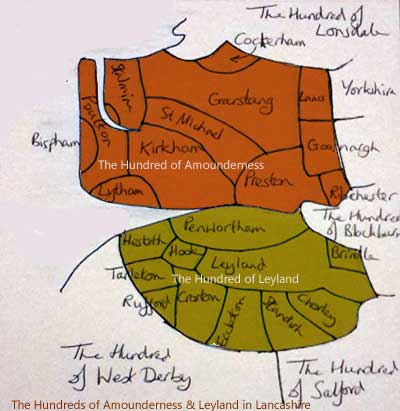
It is worth mention that Cumbria was ruled by the King of Strathclyde at this time and up to around 1100 so Preston was bordered quite closely by Mercia and Scots. (I'm still reading up on this as I'd think the border was fairly fluid as Preston was well away from the centre of power).
In the early AD1000's the Danes attacked again and took over the English throne twice but Edward the Confessor, a Saxon, took over in 1042.
Saxon rule continued until 1066 when the Normans took over. The Normans under William the Conqueror put in their own rulers all over England including in Lancashire; Roger de Poutou and the de Lacy's. An uprising in Northumbria against William caused him to sack and burn the north, mainly Yorkshire, causing the death by starvation of a lot of the population.
There is evidence of Norman fortifications on the Ribble at Ashton, Tulketh and Penwortham as well as on the Lune at Lancaster. Before this time Penwortham was a larger place than Preston but that was soon to change.
So Preston has been ruled by Romans, Saxons, Danes, Norwegians, Saxons, Danes, Saxons, Normans over a period of 600 years. Each bringing their own interpretation of God, language and laws. Although language seems to have adapted rather than changed.
Quick View of the 2nd Millenia AD - 1066 up to 1780
Photograph of the mural showing the surrender of the Jacobite Rebellion in Preston Market Square on November 14th, 1715. The mural is in Blackpool Town Hall Council Chamber, photo taken with my mobile phone, some time ago..

The town was a small gathering above the River Ribble flood plain and acted as a focus for the area taking advantage of its position at the foot of the Pennines and above the fertile flood plain. The lowest fordable point and at the limit of the tidal flow enabling vessels to get up the river.
In 1124 Tulketh Abbey was formed under the order of Sauvigny, by Stephen of Blois who was later to be king of England. In 1127 the Abbey was moved to Furness close to Morecambe Bay and became the biggest Abbey in the area. No remains can be found of Tulketh Abbey.
Around 1140 Penwortham Friary was founded under the Benedictine Order and was subserviant to Evesham Abbey. It was dissolved in 1539 and sold to John Fleetwood.
In 1179 a Royal Charter was granted giving Preston Royal Borough status and enabling its traders to travel the country without payment of tolls and duties and preventing other traders entering Preston. These traders were called Burgesses and were listed by the Guild Merchant.
Around the same time, 1169, the County of Lancashire was formed by splitting off land from Yorkshire and the Earldom of Chester. This was given by King Henry II to his son, John, as the Earldom of Lancaster. In 1352 Edward III made Lancashire a Duchy, ruled by the Duke of Lancaster, mainly because the population was small. It had the status of Crown Palatine able to appoint judges and chancellor.
In 1260 Preston Friary was founded under the order of the Franciscans by Edmund, Earl of Lancaster. It was dissolved in 1539 and sold to Thomas Holcroft.
In the 14th century the town was hit by the plague and attacks by the Scots which set it back. It wasn't much more than about 2000 people at this time and huddled around Fishergate and Friargate with a hub of todays Flag Market. In 1328 Robert the Bruce set light to the town and in that same year was a Guild Merchant. Later in 1349, some references say 3,000 died of plague in the boundary of Preston (which appears to be more than the population although it is also written that 300 left wills that are still referenced). In the 4 months from September 1349 just over 13,000 died of plague in the deanery of Amounderness, of which Preston was a part.
Preston was a regional centre but the region was poor.Over the next 400 years the town grew with the Burgesses building more property in the centre and it gradually expanding. Major landowners ran an agricultural economy. The Stanleys, Farringtons, Hoghtons, Rawstornes funded and promoted their own including Members of Parliament. In the 16th century the textile industry began to grow in the region. The Guild Merchants continued every 20 years or so from 1397.
Lancashire
Lancashire, the Duchy or Palatinate, was by most accounts in the 16th century a fairly backwards place used for hunting by the ruling classes in the forests that covered the hilly areas. With poor mossy land in the lower areas providing only subsistence farming.
In 1550 the population of Lancashire has been estimated as 90,000 and in 1650 it had increased to 160,000.
The area was ruled by the Stanleys with a number of lower families in support. There was wool and linen production largely around Manchester which at the time wasn't that much bigger than Preston. Around 90% of the population was engaged in agriculture. In the 16th century coal mining grew around Wigan and East Lancashire. The port of Liverpool tussled with Chester for trade, Liverpool being no bigger and perhaps smaller than Preston.
It has been said that a member of the Lancashire gentry would have the income and attitude of an upper yeoman in other parts of England. That the social structure and religious beliefs were less developed and although the gentry were paternalistic it was a violent place where outsiders feared to enter. Although as the century progressed the law became more formalised with an increase in legal occupations. On the plus side there was plenty of land and there were few of the landless at this time. Towns were subservient to the surrounding gentry.
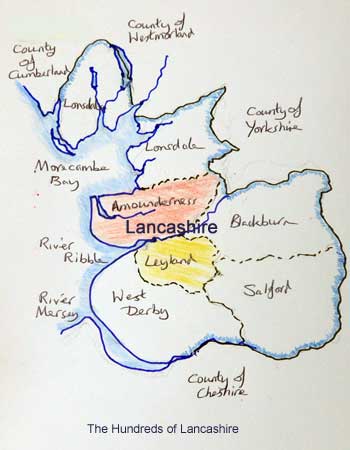
The Stanley's, Earls of Derby
The Stanley family is said to be from Stoneleigh in Staffordshire and several family branches exist. Sir John Stanley married Isobel Lathom of Lathom House near Burscough. The family prospered becoming significant in English history.
After the Battle of Bosworth in 1485 Lord Thomas Stanley was appointed 1st Earl of Derby, an ambiguous title as most people regard Derby as in Derbyshire but their seat was in West Derby, Lancashire. The family had associations with the plays of William Shakespeare.
The 7th Earl was beheaded at Bolton for supporting the Stuarts. After Lathom was besieged and its defences pulled down they developed Knowsley Hall near Liverpool. Knowsley had been a hunting lodge of Lathom House.
The Derby Horse Races were named after the family. The family held many government posts including Governor General of Canada and there is a Stanley Park in Vancouver.
The Stanley's have links to Preston. The 11th Earl, Sir Edward Stanley of Bickerstaffe Hall near Ormskirk had a second son who was born in Preston. Sir Thomas Stanley married Elizabeth Patten daughter of Thomas Patten MP for Preston.
Sir Edward Stanley born in 1689 had an office in Preston and was an alderman and Mayor in 1731-2.
Edward Smith Stanley, the 12th Earl, was born in Patten House in Preston in 1752. He was a patron of several places in Preston and instigated the Derby races. His house was on Church Street between Derby Street and Pole Street with stables across the road.
The 13th Earl, Edward Smith Stanley, became MP for Preston along with Samuel Horrocks. In 1812 he retired to become the representative for Lancashire.
The Stanley name is remembered in Preston with Stanley Street and the Stanley Arms. Stanley Parks exist in Blackpool, Liverpool and Vancouver. They donated large amounts for the building of churches and other buildings around Ormskirk as well as to several places in Preston.
It's a long and complicated family story with a lot of sources already on the internet.
National Laws - The Poor Law 1601 and Settlement Act 1662
In the 16th Century after the Reformation it is said old Christian forms of welfare began to crumble and it became necessary to list poor parishoners. This enabled churches to know who was entitled to their support in time of need. In 1572 the first compulsory welfare tax was introduced. In 1601 the Poor Law was introduced making it compulsory for Parishes to support their poor. This led to people moving between parishes if their support was better. In 1607 an amendment allowed the introduction of county based Houses of Correction for the wandering poor. In 1662 The Settlement Act was introduced so that parishes were obliged to supply a statement of settlement. Support was only offered to those listed as settled in their parish. Workhouses began to be introduced. Further acts in 1723 and 1782 allowed parishes to jointly fund workhouses and provide support only to those who entered them. As industrialisation began people moved more and the population expanded. A major amendment to the Poor Law occurred in 1834 which very much formalised and regulated the management of workhouses. Relief outside the workhouse was banned but this was soon overturned.
Preston built a workhouse in Avenham in 1675 and replaced it with another north of the town in 1788. In 1868 a new one was built in Fulwood.
Myles Standish 1584-1656
A person of uncertain birth, but believed to be Duxbury Hall just south of Chorley. Myles accompanied the Pilgrim Fathers on the Mayflower. He was Military Commander to the newly founded Plymouth Colony of New England from 1621 to 1656. As such he was a person of some standing in American and British history. The photo below is taken at the Bassetlaw Museum in Retford which is in an area where many of the Pilgrims came from and put us on the track of this. Some say Myles Standish was too aggressive but in its early phase the colony was very vulnerable.
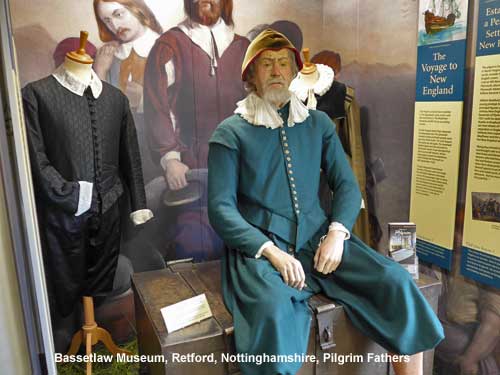
Modern Ages
Unhelpful events included the return of the plague in November 1631 which took the lives of 1100 people in Preston over a period of 12 months, a third of the population. Also the civil war from 1630 to 1650 caused upheaval. In 1642 a Guild Merchant was held with a temporary mayor as a Royalist Mayor had been elected but declared himself absent. In 1643 the Royalist Mayor, Adam Morte, was slain in Church Street by Parliamentarians. A major battle was won by Cromwell in 1648 at Preston and when Royalist and Scottish armies passed through Preston on their way south.
Battle of Preston 1715, the last battle on English soil:
In November 1715 King George's troops defeated a Jacobite Army of around 2000 in Preston. A battle was fought in Church Street and Friargate and many houses set alight. The surrounded Jacobites surrendered and prisoners held in the church until tried. Local volunteers were hung in their home towns in Lancashire.
William Gordon, 6th Viscount Kenmure
William Gordon of Scotland was appointed, despite lack of experience, commander of the Jacobite forces in the Borders. He led a force of 150 to meet with William Mackintosh of Borlum who led a force of some 2000. On 24th October 1715 they declared James Francis Edward Stuart King and marched south. Taking Lancaster unopposed. Despite winning the first day of the Battle of Preston they surrendered on 14th November and Kenmure was captured and sent to London for trial and execution (Scottish Portrait Gallery abridged).
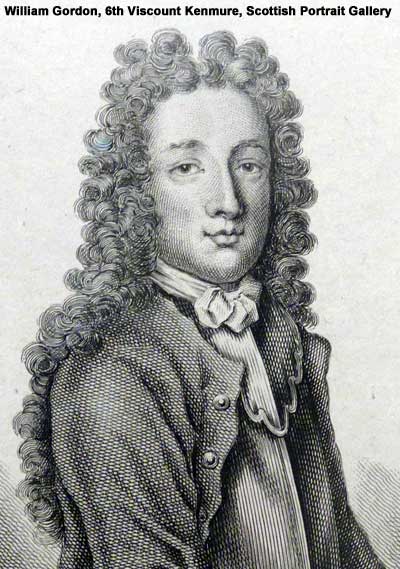
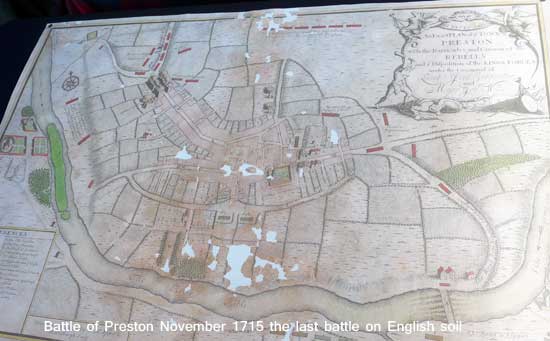
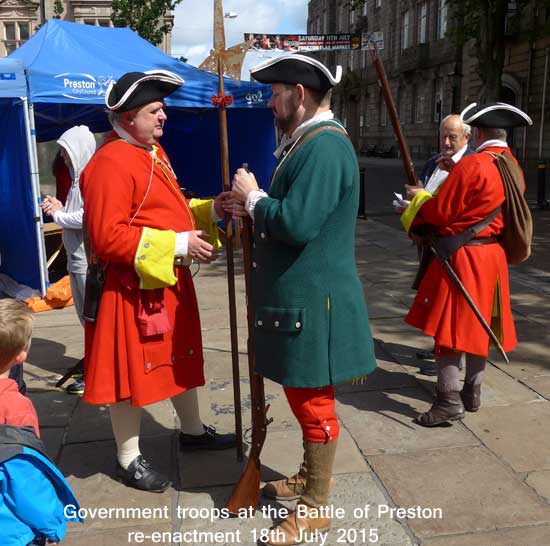
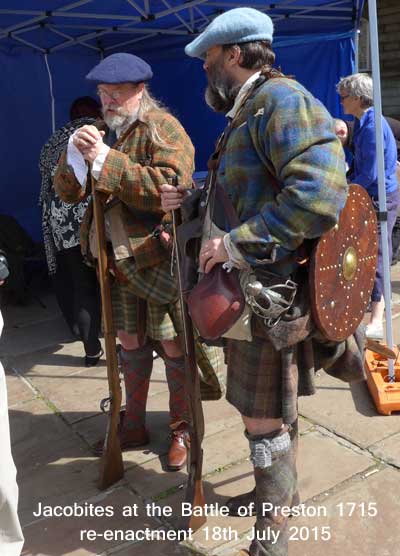
In November 1745 Bonnie Prince Charlies army occupied Preston prior to their defeat heading north.
In 1725 it was reported that Preston has no manufacture. It is full of attorneys, proctors and notaries with a different process of law to other places, it being a Duchy. Other visitors noted what a fine and gay place it was in the 18th century although 'not as wealthy as Manchester or Liverpool'. No manufacture in 1725? Yet the Guild Merchants continued every 20 years, it was in the mid 18th Century that the old ways of stopping outsiders trading in Preston became more difficult. The Guild of 1782 was a large celebration with many dignitaries.
Preston at this time was a compact town surrounded by market gardens, orchards, fields and larger houses. Even within the town centre were gardens and orchards. From a modern perspective no illusion of hygiene, cleanliness or rights should be imagined.
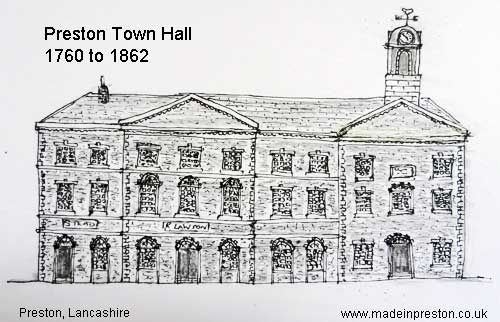
A drawing I did of the old Town Hall, seems to have an unintentional list to one side. There is a similar much smaller building in Garstang.
Preston artist Antony Devis painted by his brother Arthur Devis around 1747 as displayed in the Harris Art Gallery.

Also in this period inventions that were to change the whole region in the next 100 years, if not the world were being developed.
Preston born Sir Richard Arkwright (1732-1792) was working on his Water Frame, in what is now Arkwright House next to the Parish Church, that would enable the multi-spindled Spinning Jenny to be powered. This was patented in 1769. Although the patent was later disputed and withdrawn it was successfully implemented and made Arkwright a wealthy man. The combination of Arkwright, James Hargreaves of Oswaldtwistle with the Spinning Jenny and John Kay of Bury with the flying shuttle was a 'dream team' in fairly modern parlance although they worked separately building on each others innovation.
Arkwright moved to Derbyshire to make his fortune, see our visit to Cromford Mills page.
The next 100 years bring big change as the Industrial Revolution swept the UK and then Europe and America.Click here to continue to 1900